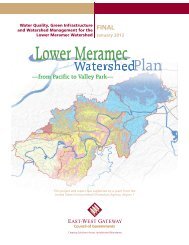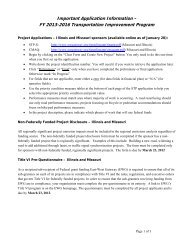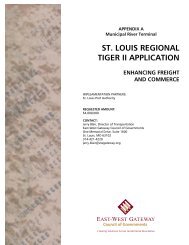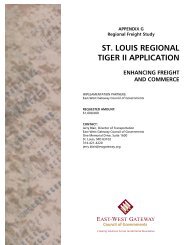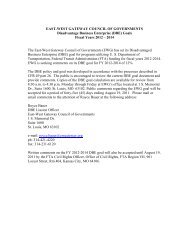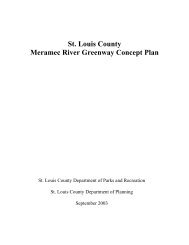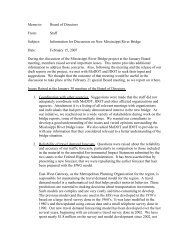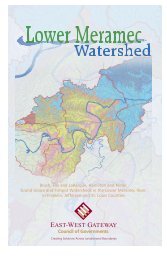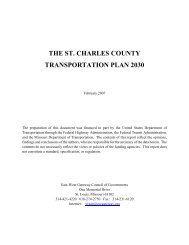Jefferson County - East-West Gateway Coordinating Council
Jefferson County - East-West Gateway Coordinating Council
Jefferson County - East-West Gateway Coordinating Council
Create successful ePaper yourself
Turn your PDF publications into a flip-book with our unique Google optimized e-Paper software.
A Regional Overview All-Hazard Mitigation Plan 5<br />
group recommended that the 1-percent-annual-chance flood (also referred to as the 100year<br />
or “Base Flood”) be used as the standard for the NFIP.<br />
The 1-percent-annual-chance flood was chosen on the basis that it provides a higher level<br />
of protection while not imposing overly stringent requirements or the burden of excessive<br />
costs on property owners. The 1-percent-annual-chance flood (or 100-year flood)<br />
represents a magnitude and frequency that has a statistical probability of being equaled or<br />
exceeded in any given year, or the 100-year flood has a 26 percent (or 1 in 4) chance of<br />
occurring over the life of a 30-year mortgage.<br />
Floodplains are a vital part of a larger entity called a watershed basin. A watershed basin is<br />
defined as all the land drained by a river and its branches. In some cases, flooding may not<br />
be attributed to a river, stream or lake. It may be the combination of excessive rainfall,<br />
snowmelt, saturated ground and inadequate drainage.<br />
Likely Locations<br />
In certain areas of <strong>Jefferson</strong> <strong>County</strong>, steep slopes of the region induce high velocities as the<br />
water flows downhill and downstream, in many cases producing flash flooding conditions.<br />
Because some areas in <strong>Jefferson</strong> <strong>County</strong> are located in low areas, and therefore, often in<br />
the floodplain, floodwaters have the potential to affect or even severely harm portions of<br />
the community, especially if the floodwalls or levees fail.<br />
There are no federal levees on the Missouri side of the Mississippi River; however there are<br />
federal levees on the Illinois side that extend as far south as Ste. Genevieve <strong>County</strong>,<br />
Missouri. During floods, these levees would force higher floodwaters to inundate the<br />
Missouri side of the river. The failure of the federal levees would lower the floodwaters<br />
and reduce the flooding impact on the Missouri side. These conditions that exist in areas<br />
where flash floods are a problem make response operations and evacuation very difficult,<br />
adversely affecting the safety of the residents.<br />
Type of Damage<br />
Damage incurred as a result of flooding includes the inundation of residences,<br />
outbuildings, businesses, churches stormwater, mud, rock, trees, debris, trash, and<br />
chemical pollutants. Depending upon the severity of the flood and the volume and rate of<br />
flow of the water, floodwaters may be capable of carrying vehicles, whole or parts of<br />
buildings, etc. Wherever they reach, floodwaters leave behind layers of thick muddy ooze.<br />
During spring and summer 1993, record flooding inundated much of the upper Mississippi<br />
River Basin. The magnitude of the damages -- in terms of property, disrupted business, and<br />
personal trauma -- was unmatched by any other flood disaster in United States history .<br />
Property damage alone was over $20 billion. Damaged highways and submerged roads<br />
disrupted overland transportation throughout the flooded region. The Mississippi and the<br />
Missouri Rivers were closed to navigation before, during, and after the flooding . Millions



